2017 Hyundai Ioniq Electric airbag
[x] Cancel search: airbagPage 145 of 582
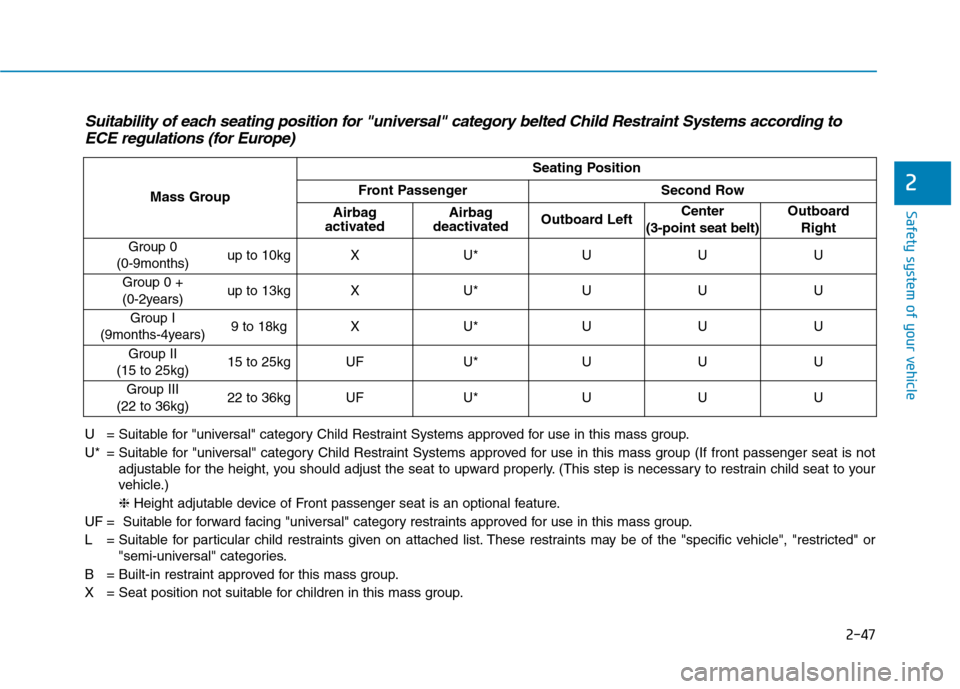
2-47
Safety system of your vehicle
2
Suitability of each seating position for "universal" category belted Child Restraint Systems according toECE regulations (for Europe)
U = Suitable for "universal" category Child Restraint Systems approved for use in this mass group.
U* = Suitable for "universal" category Child Restraint Systems approved for use in this mass group (If front passenger seat is n ot
adjustable for the height, you should adjust the seat to upward properly. (This step is necessary to restrain child seat to your
vehicle.)
❈ Height adjutable device of Front passenger seat is an optional feature.
UF = Suitable for forward facing "universal" category restraints approved for use in this mass group.
L = Suitable for particular child restraints given on attached list. These restraints may be of the "specific vehicle", "restrict ed" or
"semi-universal" categories.
B = Built-in restraint approved for this mass group.
X = Seat position not suitable for children in this mass group.
Mass Group
Seating Position
Front PassengerSecond Row
Airbag
activatedAirbag
deactivatedOutboard LeftCenter
(3-point seat belt)Outboard Right
Group 0
(0-9months)up to 10kgXU*UUU
Group 0 +
(0-2years)up to 13kgXU*UUU
Group I
(9months-4years)9 to 18kgXU*UUU
Group II
(15 to 25kg)15 to 25kgUFU*UUU
Group III
(22 to 36kg)22 to 36kgUFU*UUU
Page 146 of 582
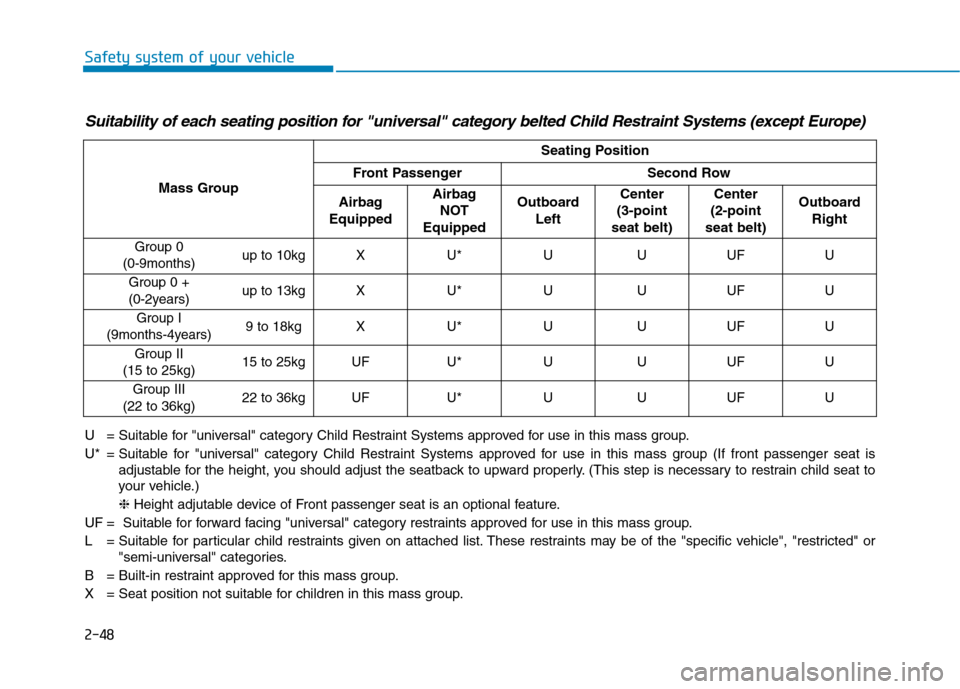
2-48
Safety system of your vehicle
Suitability of each seating position for "universal" category belted Child Restraint Systems (except Europe)
U = Suitable for "universal" category Child Restraint Systems approved for use in this mass group.
U* = Suitable for "universal" category Child Restraint Systems approved for use in this mass group (If front passenger seat isadjustable for the height, you should adjust the seatback to upward properly. (This step is necessary to restrain child seat to
your vehicle.)
❈ Height adjutable device of Front passenger seat is an optional feature.
UF = Suitable for forward facing "universal" category restraints approved for use in this mass group.
L = Suitable for particular child restraints given on attached list. These restraints may be of the "specific vehicle", "restrict ed" or
"semi-universal" categories.
B = Built-in restraint approved for this mass group.
X = Seat position not suitable for children in this mass group.
Mass Group
Seating Position
Front PassengerSecond Row
Airbag
EquippedAirbag NOT
EquippedOutboard LeftCenter
(3-point
seat belt)Center
(2-point
seat belt)Outboard Right
Group 0
(0-9months)up to 10kgXU*UUUFU
Group 0 +
(0-2years)up to 13kgXU*UUUFU
Group I
(9months-4years)9 to 18kgXU*UUUFU
Group II
(15 to 25kg)15 to 25kgUFU*UUUFU
Group III
(22 to 36kg)22 to 36kgUFU*UUUFU
Page 151 of 582
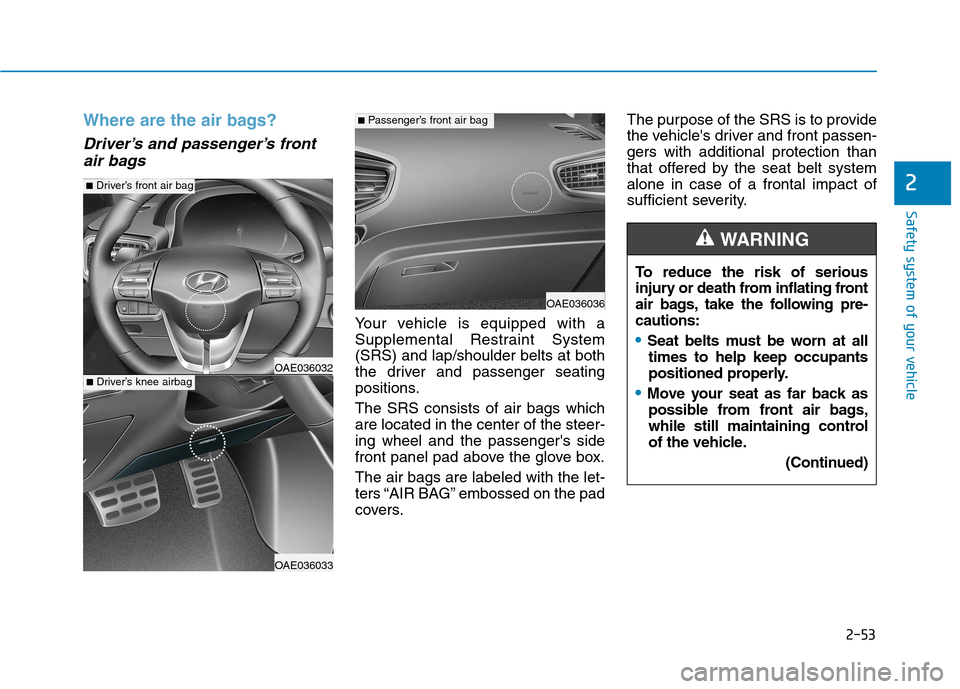
2-53
Safety system of your vehicle
2
Where are the air bags?
Driver’s and passenger’s frontair bags
Your vehicle is equipped with a
Supplemental Restraint System(SRS) and lap/shoulder belts at both
the driver and passenger seating
positions. The SRS consists of air bags which are located in the center of the steer-ing wheel and the passenger's side
front panel pad above the glove box. The air bags are labeled with the let-
ters “AIR BAG” embossed on the pad
covers. The purpose of the SRS is to provide
the vehicle's driver and front passen-gers with additional protection than
that offered by the seat belt systemalone in case of a frontal impact of
sufficient severity.
To reduce the risk of serious
injury or death from inflating front
air bags, take the following pre-cautions:
Seat belts must be worn at alltimes to help keep occupants
positioned properly.
Move your seat as far back as possible from front air bags,
while still maintaining control
of the vehicle.
(Continued)
WARNING
OAE036032
■Driver’s front air bag
OAE036033
■Driver’s knee airbag
OAE036036
■ Passenger’s front air bag
Page 154 of 582
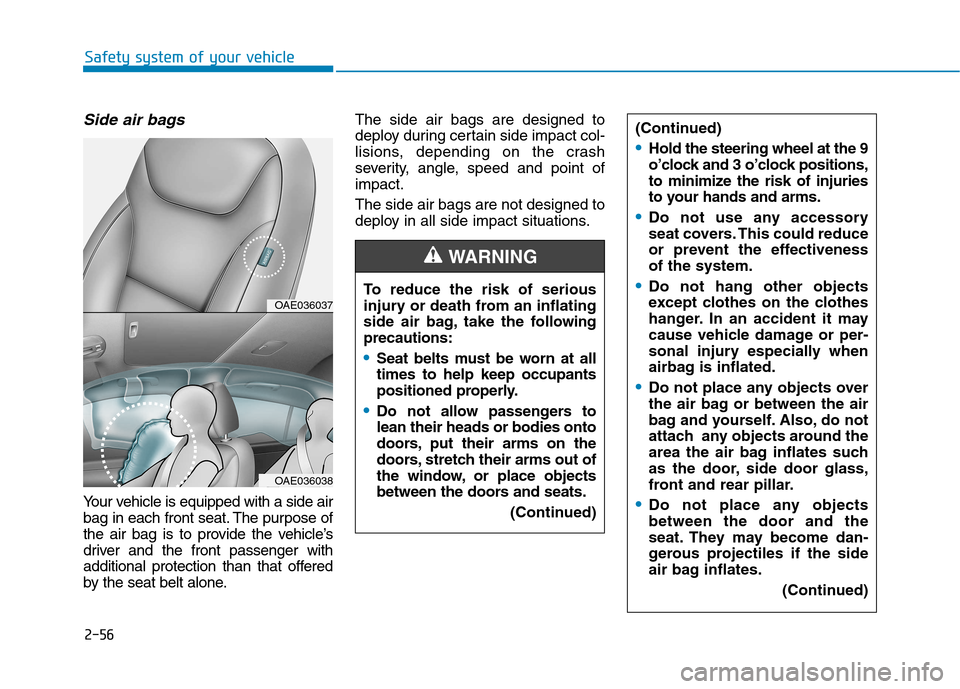
2-56
Safety system of your vehicle
Side air bags
Your vehicle is equipped with a side air
bag in each front seat. The purpose of
the air bag is to provide the vehicle’s
driver and the front passenger with
additional protection than that offered
by the seat belt alone.The side air bags are designed to
deploy during certain side impact col-
lisions, depending on the crash
severity, angle, speed and point ofimpact. The side air bags are not designed to
deploy in all side impact situations.
To reduce the risk of serious
injury or death from an inflating
side air bag, take the follo wing
precautions:
Seat belts must be worn at all times to help keep occupants
positioned properly.
Do not allow passengers to lean their heads or bodies onto
doors, put their arms on the
doors, stretch their arms out of
the window, or place objects
between the doors and seats.
(Continued)
WARNING
OAE036037
OAE036038
(Continued)
Hold the steering wheel at the 9
o’clock and 3 o’clock positions,
to minimize the risk of injuries
to your hands and arms.
Do not use any accessory
seat covers. This could reduce
or prevent the effectivenessof the system.
Do not hang other objects
except clothes on the clothes
hanger. In an accident it may
cause vehicle damage or per-
sonal injury especially when
airbag is inflated.
Do not place any objects over
the air bag or between the air
bag and yourself. Also, do not
attach any objects around the
area the air bag inflates such
as the door, side door glass,
front and rear pillar.
Do not place any objects between the door and the
seat. They may become dan-
gerous projectiles if the side
air bag inflates.(Continued)
Page 155 of 582
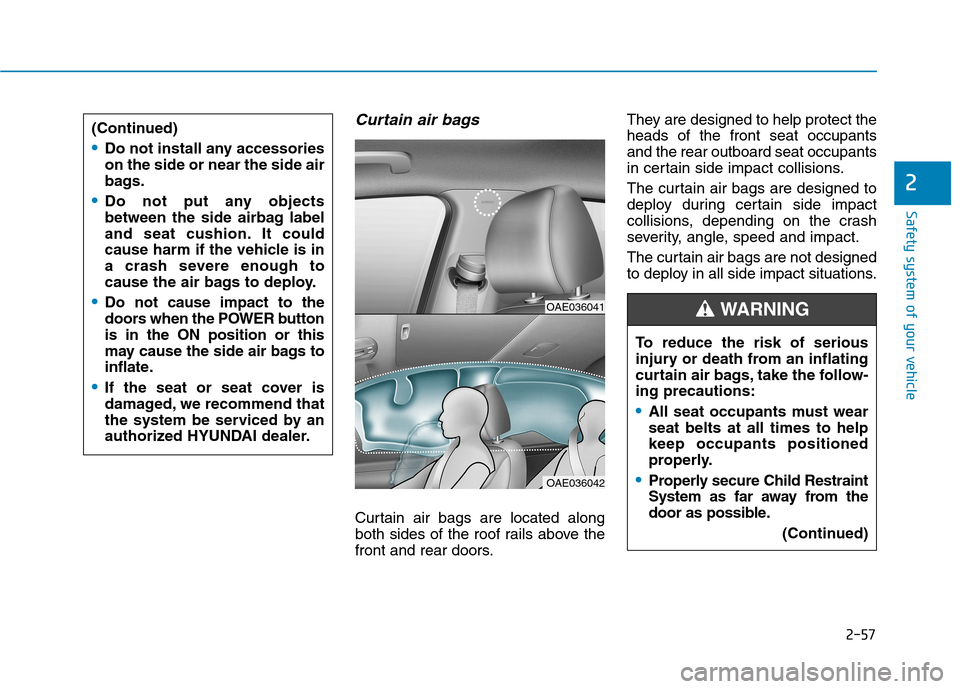
2-57
Safety system of your vehicle
2
Curtain air bags
Curtain air bags are located along
both sides of the roof rails above the
front and rear doors.They are designed to help protect theheads of the front seat occupantsand the rear outboard
seat occupants
in certain side impact collisions.
The curtain air bags are designed to
deploy during certain side impact
collisions, depending on the crash
severity, angle, speed and impact.
The curtain air bags are not designed
to deploy in all side impact situations.
(Continued)
Do not install any accessories on the side or near the side air
bags.
Do not put any objects
between the side airbag label
and seat cushion. It could
cause harm if the vehicle is in
a crash severe enough to
cause the air bags to deploy.
Do not cause impact to the
doors when the POWER buttonis in the ON position or this
may cause the side air bags to
inflate.
If the seat or seat cover is
damaged, we recommend that
the system be serviced by an
authorized HYUNDAI dealer.
OAE036041
OAE036042
To reduce the risk of serious
injury or death from an inflating
curtain air bags, take the follow-ing precautions:
All seat occupants must wear seat belts at all times to helpkeep occupants positioned
properly.
Properly secure Child Restraint
System as far away from the
door as possible.
(Continued)
WARNING
Page 156 of 582
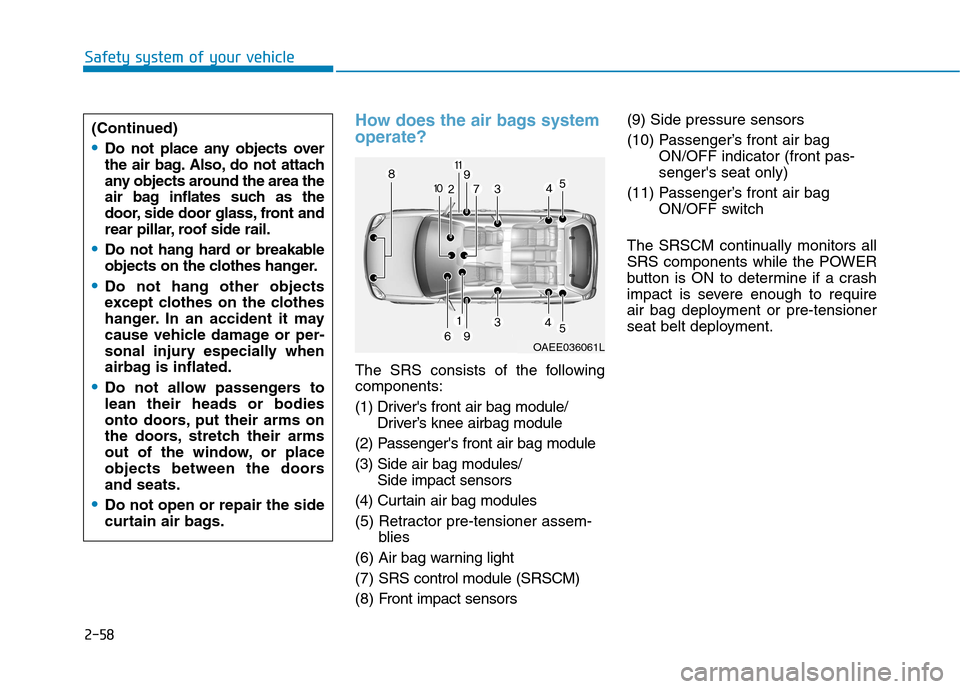
2-58
Safety system of your vehicle
How does the air bags system operate?
The SRS consists of the following components:
(1) Driver's front air bag module/Driver’s knee airbag module
(2) Passenger's front air bag module
(3) Side air bag modules/ Side impact sensors
(4) Curtain air bag modules
(5) Retractor pre-tensioner assem- blies
(6) Air bag warning light
(7) SRS control module (SRSCM)
(8) F ront impact sensors (9) Side pressure sensors
(10) Passenger’s front air bag
ON/OFF indicator (front pas- senger's seat only)
(11) Passenger’s front air bag ON/OFF switch
The SRSCM continually monitors all
SRS components while the POWER
button is ON to determine if a crash
impact is severe enough to require
air bag deployment or pre-tensioner
seat belt deployment.
(Continued)
Do not place any objects over
the air bag. Also, do not attach
any objects around the area the
air bag inflates such as the
door, side door glass, front and
rear pillar, roof side rail.
Do not hang hard or breakable
objects on the clothes hanger.
Do not hang other objects
except clothes on the clothes
hanger. In an accident it may
cause vehicle damage or per-
sonal injury especially when
airbag is inflated.
Do not allow passengers to lean their heads or bodies
onto doors, put their arms on
the doors, stretch their arms
out of the window, or place
objects between the doorsand seats.
Do not open or repair the side
curtain air bags.
OAEE036061L
Page 161 of 582

2-63
Safety system of your vehicle
2
Noise and smoke from inflatingair bag
When the air bags inflate, they make
a loud noise and may produce smoke
and powder in the air inside of the
vehicle. This is normal and is a result
of the ignition of the air bag inflator.
After the air bag inflates, you may feel
substantial discomfort in breathing
because of the contact of your chestwith both the seat belt and the air
bag, as well as from breathing the
smoke and powder. The powder may
aggravate asthma for some people. If
you experience breathing problems
after an air bag deployment, seek
medical attention immediately.
Though the smoke and powder are
nontoxic, they may cause irritation to
the skin, eyes, nose, throat, etc. If this
is the case, wash and rinse with cold
water immediately and seek medicalattention if the symptoms persist.
Do not install a Child RestraintSystem on the front passenger
seat
Never install a Child Restraint System in the front passenger seat, unless the
air bag is deactivated
OYDESA2042 NEVER use a rearward facing Child Restraint System on a seat
protected by an ACTIVE AIRBAG
in front of it, DEATH or SERIOUS
INJURY to the CHILD can occur.
WARNING